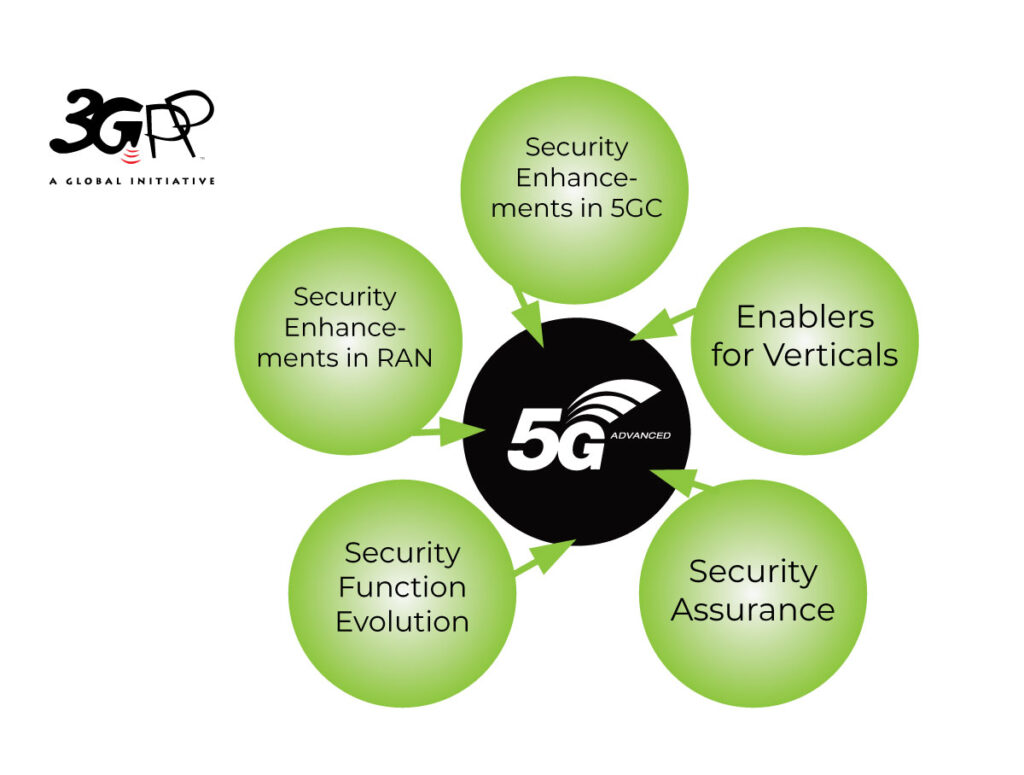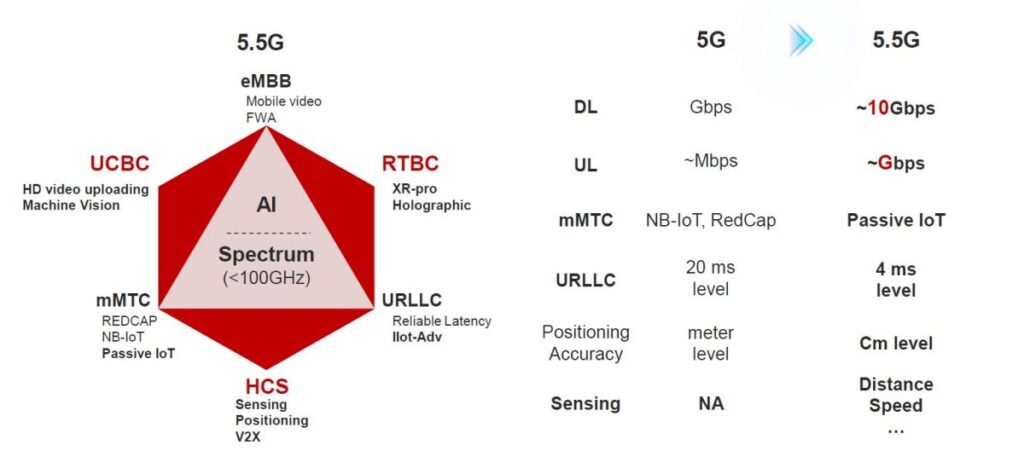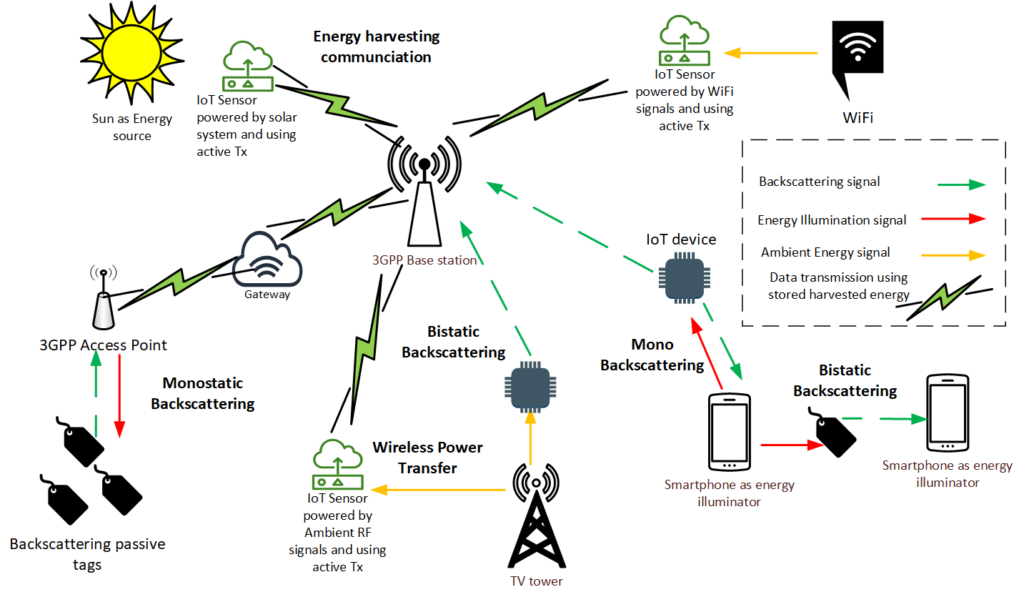Initially rolled out in 2019 for mobile broadband communications, 5G is now prepared for 5G-Advanced, which introduces features tailored for enterprise applications starting with 3GPP Release 18.
First introduced in 3GPP Release 18, 5G-Advanced (5.5G) (Figure 1) brings significant enhancements to network efficiency, latency, throughput, and coverage. It incorporates evolved multiple input multiple output (MIMO) technology, security updates, and new artificial intelligence (AI) and machine learning (ML) capabilities.

Figure 1. A detailed timeline showcasing the evolution of 5G standards from 2018 to 2029. (Image: Dell’Oro Group)
With the introduction of new features, 5G-Advanced enables applications like extended reality (XR), industrial IoT (IIoT), and smart agriculture. It is already assisting 3GPP in shaping early 6G technical specifications.
Enhancing Spectral Efficiency
5G-Advanced brings significant enhancements to massive MIMO, boosting both uplink and downlink throughput. It allows user equipment (UE) to efficiently utilize the same time and frequency resources, enhancing capacity. Spanning across multiple releases, 5G-Advanced aims to substantially enhance spectrum efficiency by:
- Enabling sub-band full duplex (SBFD) mode (Figure 2), effectively dividing the time division duplex (TDD) carrier into sub-bands for simultaneous transmission and reception within the same slots.
- Streamlining operations with multi-transmission and reception points (TRPs), enhancing single-TRP in the downlink and multi-TRP in the uplink.
- Supporting coherent joint transmissions (CJTs) in non-ideal synchronization and backhaul scenarios, such as timing mismatches, variable latency, and packet loss.
- Strengthening millimeter-wave (mmWave) capabilities to improve mobility and penetration characteristics for indoor and outdoor deployments.
- Facilitating 5 MHz spectrum bandwidth for Reduced Capacity (RedCap) 5G NR-Light devices in frequency range 1 (FR1).
- Enhancing channel state information (CSI) feedback, essential for enhancing beamforming and overall network performance.
- Optimizing dynamic spectrum sharing (DSS).
- Integrating terrestrial and satellite communications into a unified standard.

Figure 2. This 3GPP diagram illustrates 5G-Advanced security features based on Release 18. (Image: 3GPP)
Exploring the Advancing Role of AI and ML
Sophisticated AI and ML capabilities are poised to further enhance the spectral efficiency and performance of 5G-Advanced (and 6G) networks. Possible implementations include AI-enabled beam management that adjusts to dynamic environmental conditions and AI-based approaches for optimizing handovers. AI and ML can streamline network slicing by predicting and mitigating interference in real-time, as well as improve network traffic forecasting accuracy, optimize load balancing across small and macro cells, and enable precise indoor positioning inference in the absence of global navigation satellite systems (GNSS). Lastly, the cross-node implementation of AI and ML is expected to facilitate network-wide training, inference, and proactive maintenance.
Enhancing Security: From Network Automation to the Edge
5G-Advanced addresses and implements essential security enhancements (Figure 2), including:
- Expanding the N32 Interconnect Security (PRINS) protocol to support roaming hubs and intermediaries.
- Updating authentication protocols for interactions between edge clients and servers.
- Enhancing Service-Based Architecture (SBA) with new automated certificate management in cloud environments — incorporating an Internet Engineering Task Force (IETF) certificate management protocol (CMP) profile.
- Introducing 256-bit algorithms for encrypting and ensuring integrity protection of the radio interface, including a 256-bit version of the MILENAGE authentication algorithm.
- Updating the Common API Framework (CAPIF) to obtain permission from the resource owner before accessing data.
- Improving security for network automation and AI and ML, such as procedures for ML model storage and sharing, federated learning, and data analytics sharing in roaming scenarios.
- Adding security measures for UE-to-UE procedures and UE-to-network emergency services.
Expanding URLLC, RedCap, and mMTC Capabilities
5G-Advanced aims to further enhance support for deterministic networking (DetNet) by building on the time-sensitive networking (TSN) capabilities outlined in 3GPP Release 17. Strengthening ultra-reliable low latency communication (URLLC) (Figure 3), 5G-Advanced efficiently supports mission-critical applications, from IIoT and connected vehicles to AR-assisted medical procedures.

Figure 3. A comparison of key 5G and 5.5G technologies. (Image: Huawei)
5G-Advanced also expands support for Machine-Type Communication (mMTC) applications like smart metering, environmental monitoring, and smart agriculture. It enhances sensing and positioning accuracy (potentially down to sub-10 cm) for indoor and outdoor devices, significantly improving the precision of navigation, logistics, monitoring, and tracking systems.
For 5G RedCap applications such as wearables, IIoT sensors, and video surveillance, 5G-Advanced aims to enhance key capabilities introduced in Release 17, focusing on further simplifying device complexity (antenna count) and reducing power consumption. Noteworthy features in Release 18 encompass 20-MHz or 5-MHz bandwidth (in FR1), full duplex/half duplex and time division signal duplication, 64-level QAM (with 256 optional), and maximum data speeds of 10 Mbits/sec (DL and UL). 5G-Advanced also explores new use cases for RedCap, including video surveillance for industrial quality control, and discusses improved uplink capabilities for time-critical communications.
Additionally, 5G-Advanced introduces fresh objectives for ambient IoT devices (Figure 4) that harness energy from radio frequency (RF) waves, light, or motion. Ambient IoT is slated to support a wide array of use cases, from industrial wireless sensor networks and smart logistics (warehouses and storage facilities) to supply chain tracking.

Figure 4. Diagram illustrating various methods of energy harvesting for ambient IoT devices. The image depicts solar power, Wi-Fi signals, and ambient RF signals. (Image: arXiv)
Boosting XR Adoption
Encompassing augmented reality (AR), virtual reality (VR), and mixed reality (MR), XR delivers immersive and interactive experiences for gaming, training, and complex medical procedures. 5G-Advanced enhances support for XR applications by optimizing uplink and downlink scheduling and efficiently allocating bandwidth and power. Key XR features explored in 5G-Advanced include:
- Aligning UE discontinuous reception (DRX) with XR traffic periodicity to conserve power.
- Utilizing search space set group (SSSG) switching and physical downlink control channel (PDCCH) skipping to maximize capacity.
- Implementing configured grant periods with multiple physical uplink shared channel (PUSCH) intervals, enabling UEs to indicate unused occasions for reallocation by Next-Generation Node B (gNB).
- Leveraging cross-layer collaboration technology to prioritize the transmission of specific frames in XR video streams.
- Supporting synchronous transmission of multiple data streams (audio, video, control signals, and information collection signals) required for XR services, reducing time differences between various service flows.
Bridging the Gap between 5G and 6G
Mobile network operators (MNOs) anticipate that new 5G-Advanced capabilities will expand the range and scale of services they provide, from URLLC in healthcare facilities to mMTC smart agricultural networks spanning vast farmland areas. With 5G-Advanced, MNOs can offer seamless private network connectivity for autonomous vehicles, smart grids, and logistics facilities like warehouses and ports. The latest 5G standard will also assist MNOs and their clients in better complying with service level agreements (SLAs) and meeting increasingly stringent quality of service (QoS) metrics.
Bridging the divide between the two standards (Figure 5), 5G-Advanced is expected to help the industry prepare for the widespread adoption of 6G infrastructure and devices in the 2030s. While still in its early stages, 6G will build on key innovations of 5G-Advanced, delivering efficient spectrum management, expanded coverage, ultra-low latency, and increased throughput.



